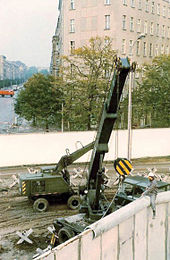Wall crown (component)

The wall crown , also known as the wall head , is the upper end of a wall. It has different functions and manifestations.
technology
Technically, the top of the wall should protect the underlying wall from moisture penetration . For this purpose, larger, flatter stone shapes are used whenever possible in order to keep the number of joints as low as possible. The joints must be worked particularly carefully and tightly. As additional protection , the top of the wall often protrudes a few centimeters and has an eaves edge. A wall crown can easily be made of unprocessed cap stones or it can be artistically designed.
In the case of dry stone walls made of sedimentary rock , the wall crown is usually made of stones placed on edge (so-called roll layer). This increases the durability of the wall quite considerably. B. stones are not thrown out so easily by people or animals climbing over them, as the stones wedge into one another. The rolling layer forms a load for the stones below and thus stabilizes them.
Functions
The top of the wall is of particular importance in:
- Fortifications where they serve military purposes
- Dam walls , where, in addition to stability, they also serve as a traffic route
